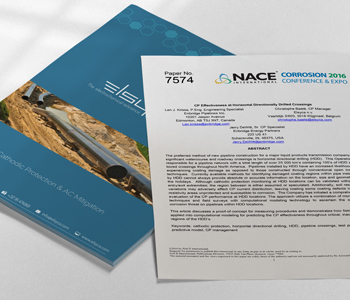
CP Effectiveness at Horizontal Directionally Drilled Crossings (NACE 2016)
This article discusses a proof-of-concept for measuring procedures and demonstrates how field data is applied into computational modeling for predicting the CP effectiveness throughout critical, inaccessible regions of the HDD’s.

CP Effectiveness at Horizontal Directionally Drilled Crossings (NACE 2016)
Christophe Baeté, Elsyca, Inc.; Len J. Krissa, Enbridge Pipelines Inc.; Jerry DeWitt, Enbridge Energy Partners.
Abstract
The preferred method of new pipeline construction for a major liquid products transmission company at significant watercourse and roadway crossings is horizontal directional drilling (HDD). This Operator is responsible for a pipeline network with a total length of over 25 000 km’s containing 100’s of HDD and bored crossings throughout North America. Pipelines installed by HDD have an increased likelihood of experiencing coating damage as opposed to those constructed through conventional open trench techniques.
Currently available methods for identifying damaged coating regions within pipe installed by HDD cannot always provide absolute or accurate information on the location, size and geometry of the holidays. Although cathodic protection monitoring at HDD locations can be validated within the entry/exit extremities; the region between is either assumed or speculated.
Additionally, soil resisivity variations may adversely affect CP current distribution, leaving coating some coating defects in high resistivity areas unprotected and susceptible to corrosion. The Company has initiated a comprehensive evaluation of the CP performance at HDD locations. The approach utilizes a combination of monitoring techniques and field surveys with computational modeling technology to ascertain the external corrosion threat on pipelines within HDD locations.
This article discusses a proof-of-concept for measuring procedures and demonstrates how field data is applied into computational modeling for predicting the CP effectiveness throughout critical, inaccessible regions of the HDD’s.
Download pdf